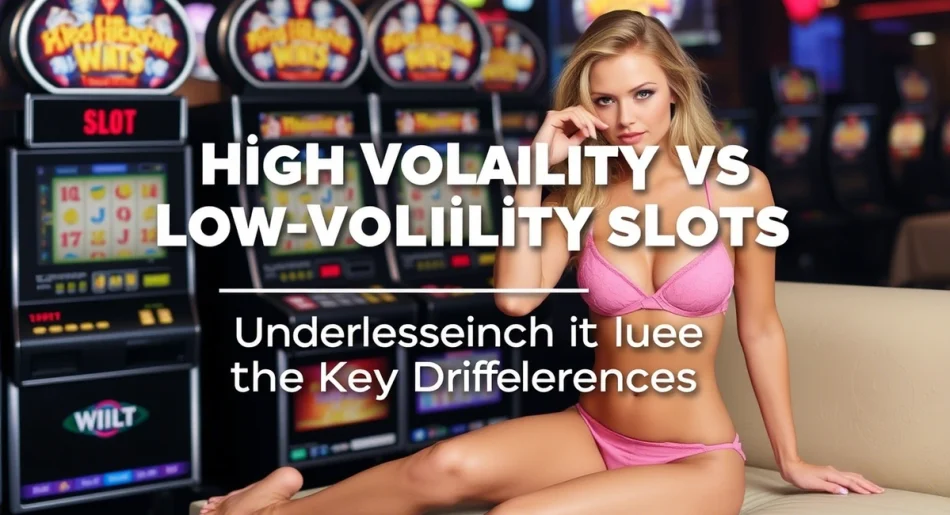High volatility vs low volatility slots is an important factor to consider when choosing a game. Understanding the differences between these types can help you select a game that fits your playing style and risk tolerance.
Volatility in slots determines how often and how much you win. This aspect plays a significant role in shaping your overall gaming experience and expected payouts.
Additionally, Slot Qris offers convenience with fast and smooth transactions. With various volatility levels, Slot Qris provides an exciting gaming experience and attractive winning opportunities.
High Volatility vs Low Volatility Slots
What Is Slot Volatility?

Slot volatility refers to how often a slot triggers a win and the typical size of those wins. High volatility vs low volatility slots plays a major role in determining the risk and reward of a game.
High volatility slots offer large payouts, but wins are less frequent. In contrast, low volatility slots provide smaller, more frequent wins, offering a steadier experience.
All slots can provide both small and big wins, and any slot can experience hot and cold streaks. The Volatility Index (VI) simply reflects the average experience you can expect.
How to find low volatility slot machines? Look for slots with a higher RTP and frequent, smaller wins, which can be a good indicator of low volatility.
Understanding Slot Machine Volatility
Volatility in slot games affects both the frequency and size of wins. High volatility vs low volatility slots plays a significant role in determining your playing style.
Players who prefer frequent wins with smaller payouts tend to choose low volatility slots, while those seeking bigger rewards with higher risk prefer high volatility slots.
- Low Volatility Slots: These slots offer more frequent wins with smaller payouts, making them ideal for players who want a stable experience with lower risk.
- High Volatility Slots: These slots offer larger wins, though less frequently, making them perfect for players who enjoy taking risks and chasing big prizes.
Low Volatility Vs High Volatility Slots Chart
Here’s a quick comparison of high volatility vs low volatility slots:
| Feature | Low Volatility Slots | High Volatility Slots |
|---|---|---|
| Payout Frequency | Frequent, smaller wins | Less frequent, larger wins |
| Risk Level | Low risk, more predictable | High risk, less predictable |
| Ideal Player | Casual players, those with smaller budgets | Risk-takers, players seeking big wins |
| Example Games | Starburst, Blood Suckers | Mega Moolah, Book of Ra |
| Gameplay Experience | Steady and stable, more spins per session | Thrilling, longer dry spells between wins |
This chart can help you visualize how high volatility vs low volatility slots differ in terms of payouts, risk, and overall experience.
High Volatility Slots
What does volatility in slots mean when the rating is “high”? A high volatility slot is one that generally has a lower payout frequency compared to medium and low volatility slots. This means wins occur less often, but when they do, the payout tends to be larger.
In the context of high volatility vs low volatility slots, the trade-off is clear. High volatility slots offer fewer wins, but when they hit, the rewards are often much larger than your initial bet, providing a greater return compared to lower volatility games.
Some of the most popular high volatility slots include:
- Big Bass Splash
- Bonanza
- Gold Blitz
- Book of Dead
- Fluffy Favourites
These games are ideal for players who enjoy higher-risk gameplay, where the excitement of a big win outweighs the potential for long periods without any payouts.
Low Volatility Slots
What does volatility in slots mean when the rating is “low”? A low volatility slot has a high payout frequency, meaning wins occur more often, but the average payout is smaller than in higher volatility games. This makes them a great option for players who prefer a more predictable gaming experience.
When comparing high volatility vs low volatility slots, the main difference lies in the frequency and size of payouts. Low volatility slots offer steady, smaller wins, while high volatility slots offer larger payouts, but less frequently.
Popular low volatility slots include:
- Starburst
- Age of the Gods: God of Storms
- Clover Rollover 2
- Fishin Frenzy Jackpot King
- Agent Jane Blonde Returns
These slots are perfect for players who want consistent rewards without the high risks associated with larger wins.
Determining the Right Volatility for You
Volatility in slots refers to how often a slot pays out and the average value of those payouts. High volatility vs low volatility slots can dramatically impact your gaming experience.
High volatility slots may require more money and patience, as wins are less frequent but can be much larger. In contrast, low volatility slots offer more frequent, smaller wins with less financial risk.
To find the best volatility for your style, ask yourself:
- Do I want a high-risk, high-reward strategy?
- Or do I prefer a low-risk, low-reward strategy?
While it’s possible to win big with low volatility slots and smaller prizes with high volatility slots, understanding the game’s payout potential is key.
If the potential is high but payouts are rare, the risk is greater. If wins come often but are smaller, the risk is lower. Choose based on whether you prefer high or low-risk gameplay.
Conclusion
Understanding high volatility vs low volatility slots is essential for selecting the right game based on your preferences and risk tolerance. High volatility slots offer the potential for large payouts, but with less frequent wins, while low volatility slots provide more consistent, smaller wins with less financial risk.
Choosing the right volatility level is key to matching your gameplay style. If you prefer high-risk, high-reward gameplay, high volatility slots are the right choice. For those who enjoy steady rewards with lower risks, low volatility slots offer a more predictable experience.

